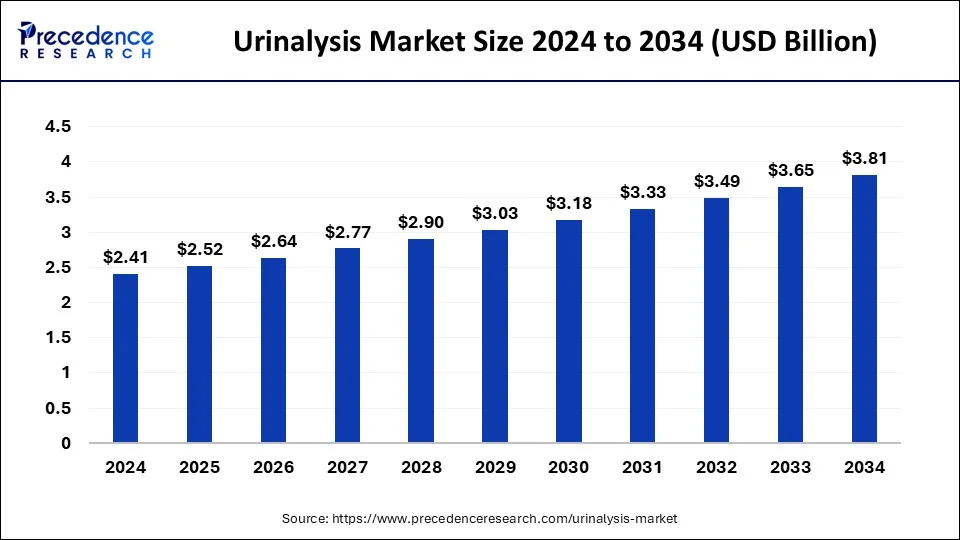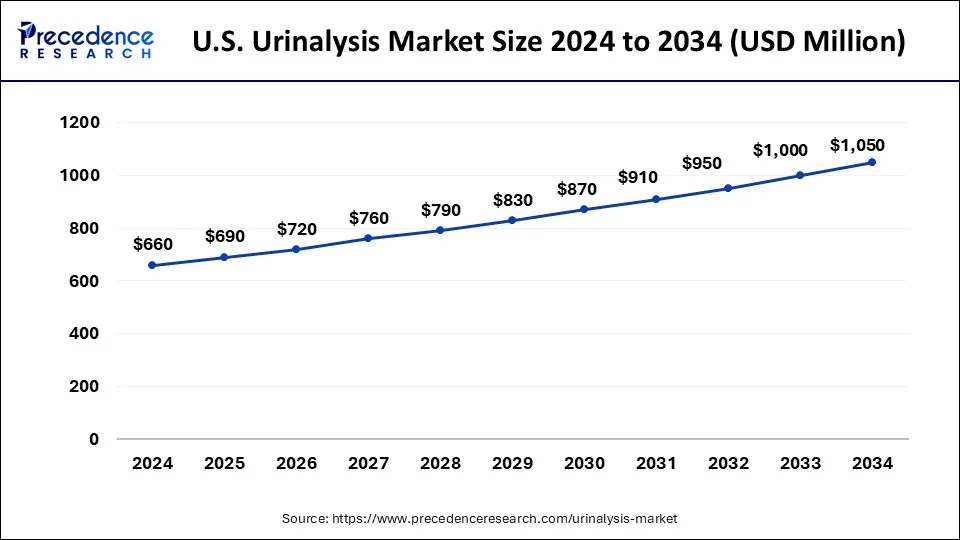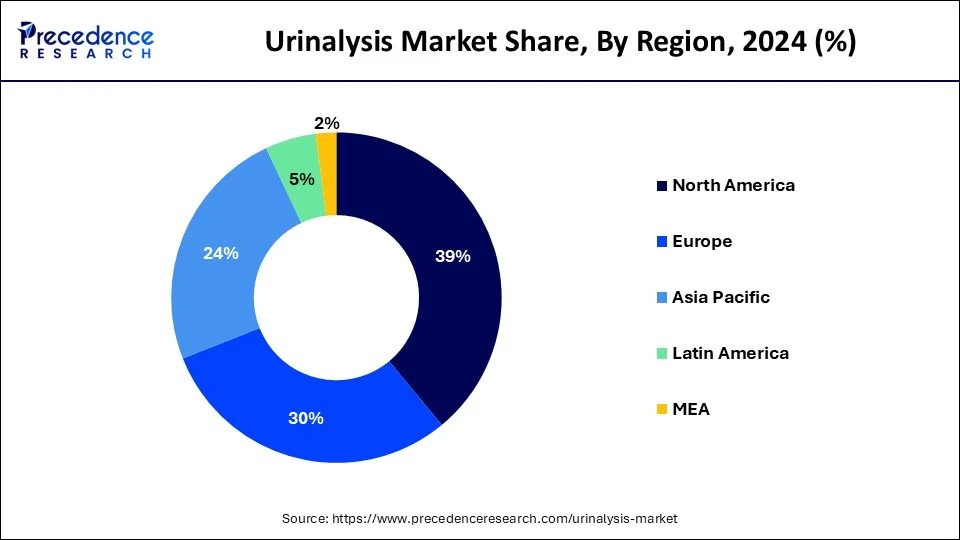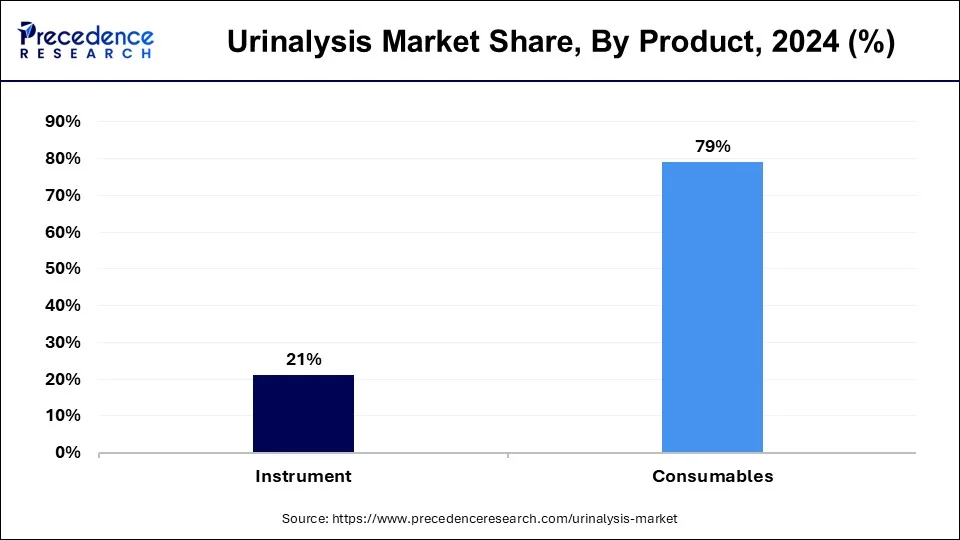April 2025
The global urinalysis market size is calculated at USD 2.52 billion in 2025 and is forecasted to reach around USD 3.81 billion by 2034, accelerating at a CAGR of 4.69% from 2025 to 2034. The North America urinalysis market size surpassed USD 940 million in 2024 and is expanding at a CAGR of 4.7% during the forecast period. The market sizing and forecasts are revenue-based (USD Million/Billion), with 2024 as the base year.
The global urinalysis market size reached USD 2.41 billion in 2024, estimated at USD 2.52 billion in 2025 and is anticipated to reach around USD 3.81 billion by 2034, expanding at a CAGR of 4.69% from 2025 to 2034. Increasing prevalence of chronic diseases, technological advancements enhancing testing accuracy and efficiency, growing demand for preventive healthcare, and expanding applications in non-clinical settings like workplace drug testing.

The U.S. urinalysis market size was estimated at USD 660 million in 2024 and is predicted to be worth around USD 1,050 million by 2034 at a CAGR of 4.75% from 2025 to 2034.

North America dominated the urinalysis market share of 39% in 2024. The region boasts a well-established healthcare infrastructure with advanced diagnostic capabilities and a high level of healthcare expenditure. This facilitates the widespread adoption of urinalysis tests across various healthcare settings, including hospitals, clinics, and diagnostic laboratories. Additionally, the region has a high prevalence of chronic diseases such as diabetes, kidney disorders, and urinary tract infections, driving the demand for diagnostic tests like urinalysis. Moreover, favorable reimbursement policies and regulatory frameworks further support market growth by incentivizing healthcare providers to perform routine screenings and diagnostic tests.

Asia Pacific is expected to witness the fastest rate of growth in the urinalysis market during the forecast period. Asia Pacific is emerging as a significant segment in the urinalysis market due to several factors. Firstly, rapid urbanization and economic development in countries like China, India, and Southeast Asian nations are leading to improved healthcare infrastructure and increased healthcare spending. This facilitates greater access to diagnostic services, including urinalysis, among the growing population. Additionally, rising awareness about preventive healthcare measures and the increasing prevalence of chronic diseases in the region drives the demand for diagnostic tests. Furthermore, advancements in healthcare technology and the introduction of innovative urinalysis products cater to the evolving needs of healthcare providers and patients in the region, further fueling market growth.
A urinalysis is a fundamental tool in healthcare settings, utilized in hospitals, clinics, laboratories, and even at home for routine health monitoring. It plays a crucial role in the early detection and management of diseases such as urinary tract infections, kidney disorders, diabetes, and liver diseases. The urinalysis market refers to the healthcare industry sector focused on analyzing urine samples to diagnose various medical conditions and monitor health. It encompasses a range of diagnostic tests and equipment used to examine urine composition, including physical, chemical, and microscopic properties.
The application of urinalysis is multifaceted, with its primary purpose being diagnostic. It enables healthcare providers to obtain valuable insights into a patient's health status, guiding treatment decisions and disease management strategies. Moreover, urinalysis is integral in preventive medicine, allowing for the early detection of underlying health issues before they manifest into more serious conditions.
Beyond clinical settings, urinalysis is also utilized in occupational health for drug screening purposes and in research settings to investigate various aspects of human physiology and pathology. With advancements in technology, such as automated analyzers and point-of-care testing devices, the urinalysis market continues to evolve, offering more accurate and efficient diagnostic solutions to healthcare professionals worldwide.
| Report Coverage | Details |
| Market Size in 2024 | USD 2.41 Billion |
| Market Size in 2025 | USD 2.52 Billion |
| Market Size by 2034 | USD 3.81 Billion |
| Growth Rate from 2025 to 2034 | CAGR of 4.69% |
| Dominated Region | North America |
| Base Year | 2024 |
| Forecast Period | 2025 to 2034 |
| Segments Covered | By Product, By Application, and By End-use |
| Regions Covered | North America, Europe, Asia-Pacific, Latin America, and Middle East & Africa |
Technological advancements
The urinalysis market is experiencing rapid growth propelled by continuous advancements in technology. Innovations such as automated urine analyzers, smartphone-compatible testing kits, and portable point-of-care devices have revolutionized the landscape of urinalysis. These technological advancements have significantly improved the accuracy, speed, and efficiency of urine testing procedures, allowing for more precise diagnosis and monitoring of various medical conditions.
Automated analyzers, equipped with advanced algorithms and image recognition capabilities, can quickly analyze urine samples and provide detailed reports, reducing the reliance on manual interpretation and minimizing the risk of errors. Moreover, the integration of wireless connectivity features in modern urinalysis devices enables seamless data transmission and remote monitoring, facilitating enhanced patient care and clinical decision-making. As technology continues to evolve, the urinalysis market is expected to witness further growth, with continuous innovation driving the development of more advanced diagnostic solutions.
Regulatory challenges
One significant restraint in the urinalysis market is the complex and evolving regulatory landscape governing medical devices and diagnostic tests. Stringent regulations and compliance requirements, including the need for premarket approvals and adherence to quality standards, can significantly delay product development, approval, and market entry.
Additionally, changes in regulatory policies and requirements across different regions create uncertainties for manufacturers, impacting investment decisions and market expansion strategies. Navigating these regulatory hurdles adds complexity and costs to bringing urinalysis products to market, posing a challenge for companies aiming to innovate and grow in this space.
Integration of artificial intelligence and machine learning in transforming urinalysis
One significant opportunity in the urinalysis market lies in the integration of artificial intelligence (AI) and machine learning (ML) technologies. These advanced analytical tools have the potential to revolutionize urinalysis by enhancing diagnostic accuracy, efficiency, and predictive capabilities. AI algorithms can analyze vast amounts of urine data quickly, identifying subtle patterns and biomarkers indicative of various health conditions with high precision.
With the advent of AI-powered urinalysis platforms, healthcare providers can streamline diagnostic workflows, reduce turnaround times, and make more informed treatment decisions. These technologies offer personalized insights into patients' health status, enabling early detection of diseases and proactive intervention strategies. Moreover, AI-driven urinalysis solutions can identify biomarker signatures associated with specific diseases, facilitating targeted therapies and precision medicine approaches.
ML algorithms can continuously learn and improve from new data inputs, leading to increasingly accurate diagnostic interpretations over time. As AI and ML technologies continue to evolve, the potential applications in urinalysis expand, ranging from disease screening and monitoring to therapeutic response prediction and drug development.
The consumables segment dominated the urinalysis market share of 79% in 2024 due to their essential role in conducting routine diagnostic tests. These consumables are indispensable components of urinalysis procedures, required for detecting various biomarkers and analytes present in urine samples. With the increasing prevalence of urinary tract infections, kidney disorders, and diabetes, the demand for consumables remains consistently high. Moreover, the repetitive nature of urinalysis testing necessitates frequent replenishment of consumables, ensuring a steady revenue stream for manufacturers in this segment.

The instruments segment is expected to witness the fastest rate of expansion in the urinalysis market during the forecast period. Due to their ability to streamline and automate diagnostic processes, efficiency and accuracy are improved. These instruments offer advanced functionalities, such as high throughput testing, integration with laboratory information systems, and connectivity for data management. Healthcare facilities and laboratories prefer investing in instruments to enhance workflow efficiency, reduce turnaround times, and meet increasing testing volumes. Additionally, advancements in technology have led to the development of compact and user-friendly instruments, expanding their adoption in various healthcare settings, from hospitals to physician offices and clinics.
The disease screening segment dominated the urinalysis market in 2024 due to its crucial role in the early detection and management of various medical conditions. Urinalysis is a cost-effective and non-invasive method for screening diseases such as urinary tract infections, kidney diseases, and diabetes. With the global burden of chronic diseases on the rise, healthcare providers prioritize routine screening programs, driving the demand for urinalysis tests. Additionally, advancements in technology have led to the development of rapid and accurate urinalysis methods, further fueling the dominance of this segment in the market.
The fertility and testing segment is expected to witness the fastest rate of expansion in the urinalysis market during the forecast period. Fertility and pregnancy testing represent another dominant application in the urinalysis market due to the widespread use of urine-based assays for detecting hormones and biomarkers associated with reproductive health. Urinalysis plays a crucial role in assessing fertility status, ovulation prediction, and confirming pregnancy. The convenience and accessibility of urine-based tests make them popular choices for individuals seeking to monitor their reproductive health at home or in clinical settings. As fertility issues and prenatal care remain significant concerns globally, the demand for urinalysis tests in this segment continues to grow steadily, contributing to its dominance in the market.
The hospitals segment led the urinalysis market with the largest share in 2024. Hospitals typically have advanced diagnostic laboratories equipped with state-of-the-art urinalysis equipment and technology. This enables healthcare professionals to conduct a wide range of tests efficiently and accurately, facilitating prompt diagnosis and treatment of various medical conditions. Hospitals offer comprehensive healthcare services encompassing preventive care, diagnostic testing, treatment, and follow-up care. Urinalysis is a routine diagnostic procedure performed in hospitals as part of general health screenings, preoperative assessments, disease monitoring, and management of chronic conditions.
By Product
By Application
By End-use
By Geography
For inquiries regarding discounts, bulk purchases, or customization requests, please contact us at sales@precedenceresearch.com
No cookie-cutter, only authentic analysis – take the 1st step to become a Precedence Research client
April 2025